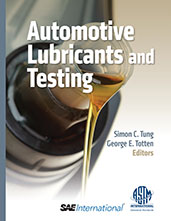Technical Paper
Engine Oil Effects on Friction and Wear Using 2.2L Direct Injection Diesel Engine Components for Bench Testing Part 2: Tribology Bench Test Results and Surface Analyses
2004-06-08
2004-01-2005
The effects of lubricating oil on friction and wear were investigated using light-duty 2.2L compression ignition direct injection (CIDI) engine components for bench testing. A matrix of test oils varying in viscosity, friction modifier level and chemistry, and base stock chemistry (mineral and synthetic) was investigated. Among all engine oils used for bench tests, the engine oil containing MoDTC friction modifier showed the lowest friction compared with the engine oils with organic friction modifier or the other engine oils without any friction modifier. Mineral-based engine oils of the same viscosity grade and oil formulation had slightly lower friction than synthetic-based engine oils.

